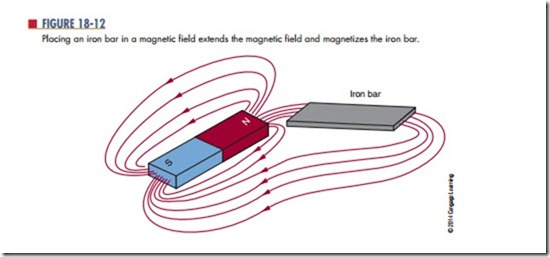Magnetic induction
Magnetic induction is the effect a magnet has on an object without physical contact. For example, a mag- net may induce a magnetic field in an iron bar (Figure 18-12). In passing through the iron bar, the magnetic lines of force cause the domains in the iron bar to align in one direction. The iron bar is now a magnet. The domains in the iron bar align themselves with their south pole toward the north pole of the magnet, because opposite poles attract. For the same reason, the iron bar is drawn toward the magnet. The flux lines now leave from the end of the iron bar; the iron bar is an extension of the magnet. This is an effective way to increase the length or change the shape of a magnet without physically altering it.
When the magnet and iron bar are separated, the domains in the iron bar return to their random pat- tern, although a few domains remain in north–south alignment, giving the iron bar a weak magnetic field. This remaining magnetic field is called residual magnetism. The ability of a material to retain its magnetic field after the magnetizing force is removed is called retentivity. Soft iron has low retentivity. Alnico, an alloy made of aluminum, nickel, and cobalt, has high retentivity.
Inserting a low reluctance material in front of the magnetic field can bend flux lines. Low-reluctance materials are called magnetic shields. An example is the material called Mu-metal. The magnetic shield is placed around the item to be protected. Electronic equipment, especially oscilloscopes, requires shielding from magnetic flux lines.
electromagnetic induction is the principle be- hind the generation of electricity: When a conductor passes or is passed by a magnetic field, a current is produced (induced) in the conductor. As the conductor passes through the magnetic field, free electrons are forced to one end of the conductor, leaving a deficiency of electrons at the other end. This results in a difference of potential between the ends of the conductor. This difference of potential exists only when the conductor is passing through a magnetic field. When the conductor is removed from the magnetic field, the free electrons return to their parent atoms.
For electromagnetic induction to occur, either the conductor must move or the magnetic field must move. The voltage produced in the conductor is called induced voltage. The strength of the magnetic field, the speed with which the conductor moves through the magnetic field, the angle at which the conductor cuts the magnetic field, and the length of the conductor determine the amount of induced voltage.
The stronger the magnetic field, the greater the induced voltage. The faster the conductor moves through the field, the greater the induced voltage. Moving the conductor, the magnetic field, or both can produce motion between the conductor and the mag- netic field. The maximum voltage is induced when the conductor moves at right angles to the field. Angles less than 90º induce less voltage. If a conductor is moved parallel to the flux lines, no voltage is induced. The longer the conductor is moving through the magnetic field, the greater the induced voltage.
Faraday’s law, the basic law of electromagnetism, states: The induced voltage in a conductor is directly proportional to the rate at which the conductor cuts the magnetic lines of force.
The polarity of an induced voltage can b e determined by the following left–hand rule for generators: The thumb, index finger, and middle finger are held at right angles to each other (Figure 18-13). The thumb points in the same direction as the motion of the conductor, the index finger points in the direction of the flux lines (north to south), and the middle finger points toward the negative end of the conductor, the direction of the current flow.
Questions
1. How can the length of a magnet be increased without physically altering the magnet?
2. What is residual magnetism?
3. How does a magnetic shield work?
4. How is electromagnetic induction used to generate electricity?
What does Faraday’s law state?

